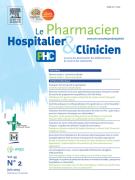Pertinence et efficience d’une nouvelle méthodologie d’analyse pharmaceutique des prescriptions au CHU de Dijon - 13/03/21
Relevance and efficiency of a new methodology for the pharmaceutical analysis of prescriptions at Dijon University Hospital
 , Bastian Fouquier, Charlotte Malbranche, Christelle Prudent
, Bastian Fouquier, Charlotte Malbranche, Christelle Prudent| pages | 8 |
| Iconographies | 0 |
| Vidéos | 0 |
| Autres | 0 |
Résumé |
Introduction |
Suite à l’arrêté du 6 avril 2011, de nombreuses équipes pharmaceutiques élaborent des critères afin de prioriser l’analyse pharmaceutique des prescriptions les plus à risque iatrogène. L’objectif de cette étude comparative monocentrique est d’évaluer l’efficacité et la pertinence d’une nouvelle méthodologie priorisant les prescriptions comprenant un médicament à risque, une anomalie biologique ou un médicament inapproprié chez le patient âgé.
Matériel et méthode |
Sur deux périodes de deux mois espacées de six mois, l’étude a inclus toutes les prescriptions analysées selon le niveau 2 SFPC. Trois indicateurs ont été étudiés : la production, l’impact et la gravité des interventions pharmaceutiques (IP) via le taux d’intervention, le taux d’acceptation et la cotation selon l’échelle CLEO.
Résultats |
Le taux d’intervention (12 % versus 9,9 % ; p<0,01) et le taux d’acceptation (47,7 % versus 36,3 % ; p<0,01) ont été significativement améliorés. Les IP sont en lien avec un critère de priorisation dans 48 % des cas. Une augmentation de la gravité potentielle de l’IP améliore le taux d’acceptation.
Discussion et conclusion |
L’évolution de notre méthodologie de priorisation des prescriptions à analyser a amélioré l’efficacité et la pertinence de notre analyse pharmaceutique. Le développement de progiciels et de l’intelligence artificielle devrait permettre d’aller plus loin dans la démarche.
Le texte complet de cet article est disponible en PDF.Summary |
Introduction |
Following the decree of April 6, 2011, many pharmaceutical teams are developing criteria to prioritize the pharmaceutical analysis of prescriptions with the highest iatrogenic risk. The objective of this monocentric comparative study is to evaluate the efficacy and relevance of a new methodology prioritizing prescriptions containing a high-risk drug, a biological abnormality or an inappropriate drug in elderly patients.
Material and methods |
Over two two-month periods six months apart, the study included all prescriptions analyzed at level 2 SFPC. Three indicators were studied: production, impact and severity of pharmaceutical interventions (PIs) through intervention rate, acceptance rate and CLEO rating.
Results |
The intervention rate (12 % versus 9.9 %; P<0.01) and the acceptance rate (47.7 % versus 36.3 %; P<0,01) were significantly improved. PIs are linked to a prioritization criterion in 48 % of cases. An increase in the potential severity of the PI improves the acceptance rate.
Discussion and conclusion |
The evolution of our methodology for prioritizing the prescriptions to be analyzed has improved the efficiency and relevance of our pharmaceutical analysis. The development of software packages and artificial intelligence should allow us to go further in this process.
Le texte complet de cet article est disponible en PDF.Mots clés : Analyse pharmaceutique, Optimisation, Pertinence, Pharmacie clinique
Keywords : Pharmaceutical analysis, Optimization, Relevance, Clinical pharmacy
Plan
Vol 56 - N° 1
P. 52-59 - mars 2021 Retour au numéroBienvenue sur EM-consulte, la référence des professionnels de santé.
L’accès au texte intégral de cet article nécessite un abonnement.
Bienvenue sur EM-consulte, la référence des professionnels de santé.
L’achat d’article à l’unité est indisponible à l’heure actuelle.
Déjà abonné à cette revue ?

